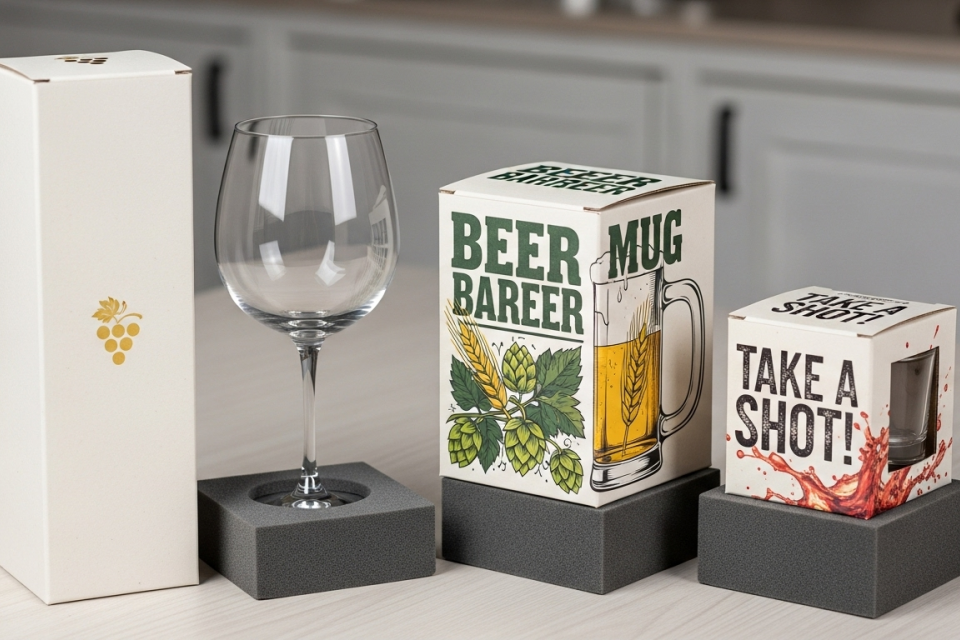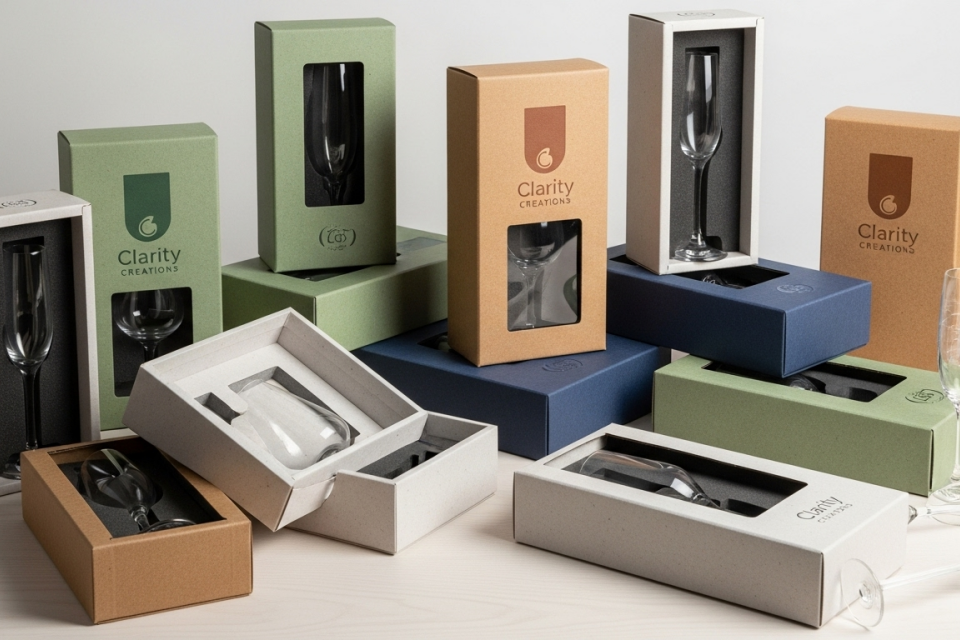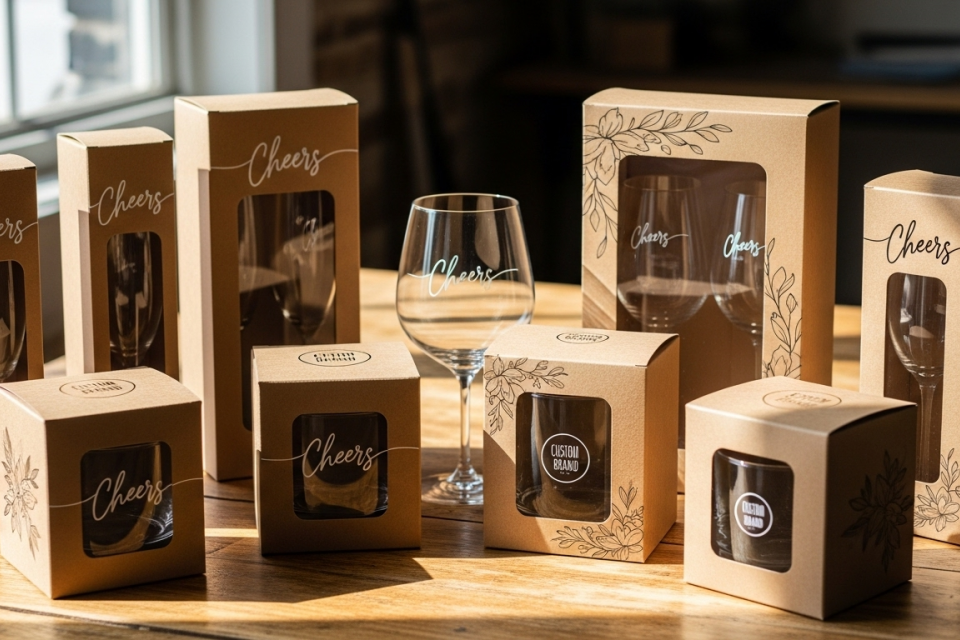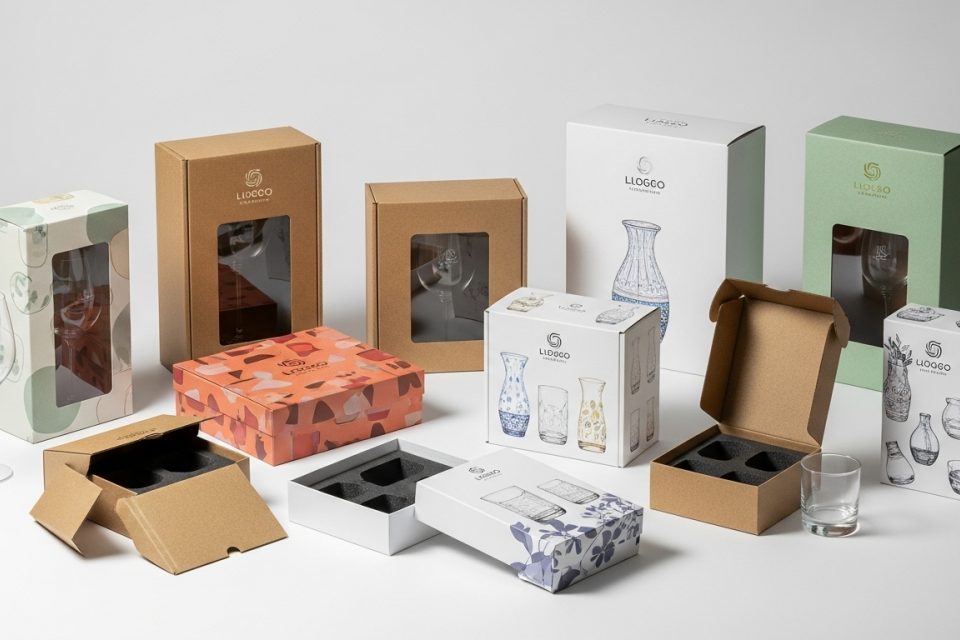Partitioned Boxes for Glass Sets
This article explores partitioned boxes for glass, covering their design, materials, and benefits in providing safe and sustainable transport for fragile items.
Summary
Partitioned boxes for glass sets are specialized packaging solutions designed to safely transport and store delicate glass items, such as drinking glasses, decorative pieces, and collectibles. These boxes utilize robust materials, particularly corrugated cardboard, which provides a balance of lightweight cushioning and structural integrity essential for protecting fragile contents during transit. Their design typically incorporates customized dividers that create individual compartments, minimizing movement and significantly reducing the risk of breakage.
The notable demand for partitioned boxes arises from their effectiveness in safeguarding glassware against damage, making them a preferred choice for consumers and businesses alike. With the growing emphasis on sustainability, many manufacturers are adopting eco-friendly practices by using recyclable materials, aligning their products with the increasing consumer preference for environmentally responsible packaging solutions. This dual focus on protection and sustainability has led to a substantial growth in the market for these specialized boxes, projected to reach USD 3.11 billion by 2034, reflecting a compound annual growth rate (CAGR) of about 6.34%.
Several design features distinguish partitioned boxes, including the customization of flute profiles within the corrugated structure to accommodate various types of glassware, as well as ergonomic considerations that facilitate easy handling. Additionally, the aesthetic appeal of these boxes has been enhanced through the integration of branding elements and attractive graphics, making them not only functional but also visually appealing to consumers seeking both utility and style.
Controversies surrounding partitioned boxes often relate to the balance between cost and quality, with consumers weighing the benefits of customized options against their higher prices compared to standard boxes. As the market evolves, manufacturers continue to innovate, addressing these concerns while expanding their product offerings to cater to a diverse range of consumer needs and preferences.
Table of Contents
Design
Overview of Partitioned Boxes
The design of partitioned boxes for glass sets is a crucial aspect of ensuring the safe transport and storage of delicate glass items. These boxes are engineered to provide robust protection, utilizing materials such as corrugated paper, which offers a combination of cushioning and structural integrity. The unique construction involves bonding two outer layers of flat paper with an inner layer shaped into a corrugated structure, enhancing durability and resistance to impacts during transit.
Key Design Features
Material Selection
When designing partitioned boxes, the choice of materials plays a significant role. Corrugated cardboard is widely used due to its lightweight yet sturdy nature, making it ideal for packaging fragile items like glass. Additionally, some manufacturers opt for high-quality paper with increased thickness to provide extra protection against breakage, ensuring that the boxes can withstand various environmental conditions.
Flute Profiles and Customization
The flute profiles within the corrugated structure are tailored to accommodate different types of glassware. Narrow flutes are suitable for lightweight items and intricate designs, while wider flutes are used for heavier and more fragile glass pieces. Customizing these profiles allows for a more secure fit, minimizing movement within the box and reducing the risk of damage during transport.
Ergonomic Considerations
Designers also prioritize ergonomic features in partitioned boxes. This includes easy-to-carry handles and lightweight designs that facilitate handling without compromising protection. The aim is to create a user-friendly experience, allowing consumers to transport their glass sets safely and conveniently.
Aesthetic and Functional Integration
In addition to functionality, the aesthetic appeal of partitioned boxes is considered in the design process. Many manufacturers incorporate branding elements and visually pleasing graphics that enhance the overall presentation of the packaging. This approach not only reinforces the brand identity but also adds a layer of sophistication to the product, making it appealing to consumers looking for both utility and style.
Environmental Impact
Sustainability is an increasingly important factor in the design of partitioned boxes. Many are made from recyclable materials, aligning with eco-friendly practices and reducing the environmental footprint of packaging waste. The use of recyclable and biodegradable materials in production processes contributes to a more sustainable approach in the packaging industry, appealing to environmentally conscious consumers.
By focusing on these design elements, partitioned boxes for glass sets achieve a balance of safety, functionality, and aesthetic appeal, catering to the needs of both manufacturers and end-users.

Types of Partitioned Boxes
Partitioned boxes come in various types, each designed to cater to specific storage and shipping needs for glassware and other fragile items. These boxes provide tailored protection and organization, ensuring the safe transit of delicate products.
Customized Partition Boxes
Customized partition boxes are specifically made through a die-cutting process to meet particular needs. These boxes can be designed to accommodate unique shapes of glass items, including those with curved stems or angled bases. Although they are typically more expensive than standard boxes, their ability to provide a perfect fit and optimal protection for fragile glassware makes them a worthwhile investment.
Multi-Product Partition Boxes
Multi-product partition boxes feature built-in partitions or inserts, which create individual storage areas for separate glasses. This design prevents movement and collisions between items, making these boxes ideal for sets of glassware that must remain intact during transit. The partitions ensure that each piece is secured, minimizing the risk of damage.
Cylindrical Boxes
Cylindrical boxes are another type of partitioned packaging designed specifically for round items. These boxes include symmetrical spaces that keep each glass securely in place, reducing movement and enhancing protection during shipping. This design is particularly useful when handling delicate cylindrical glassware, as it mitigates the risk of breakage.
Moving & Storage Boxes with Dividers
For consumer moving, organizing, and storage needs, various kits offer dividers specifically designed for fragile items such as mugs, glassware, and ornaments. These kits can be customized to create different-sized cells within a single box, allowing for versatile use. Additionally, many of these partitions are made from recyclable materials, appealing to environmentally conscious consumers and businesses.

Benefits of Partitioned Boxes
The use of partitioned boxes ensures that glassware and similar items are protected from damage during transit. When items are snugly fitted within the partitions, they experience less movement, which is essential given that boxes may not always be handled with care. This protective measure helps guarantee that all items arrive at their destination in the same condition as when they were packed.
Uses
Partitioned boxes for glass sets serve multiple purposes, providing safe and organized storage for delicate items. Primarily, these boxes are designed for moving, protecting fragile glassware such as drinking glasses, mugs, and decorative items from breakage during transit. Their customizable dividers allow users to create separate compartments tailored to the size and shape of their specific glassware, ensuring that each piece is securely held in place to prevent damage.
In addition to moving, these partitioned boxes are also beneficial for long-term storage. Homeowners and businesses alike can utilize them to organize their glassware collection, keeping items accessible while safeguarding them against dust, scratches, and potential accidents. The boxes are particularly appealing to environmentally conscious consumers, as many options are made from recyclable materials, aligning with sustainable living practices.
Furthermore, partitioned boxes can be utilized in retail and display settings. Businesses that sell glass products often employ these storage solutions to showcase items while maintaining a secure environment, enhancing both organization and visual appeal. This is especially relevant for high-end glass items, where aesthetics and security are paramount in attracting discerning customers.
Benefits
Partitioned boxes offer numerous advantages for the storage and shipping of glass sets, primarily focused on protection, efficiency, and sustainability.
Enhanced Protection
One of the primary benefits of using partitioned boxes is the enhanced protection they provide for fragile items, particularly glassware. When properly designed, these boxes feature dividers that create individual compartments for each piece, preventing them from coming into contact with one another during transit. This is crucial, as glass is susceptible to breaking or shattering even with minimal impact, making partitioned boxes essential for safeguarding valuable glass products. The snug fit offered by the partitions further reduces movement, mitigating the risk of damage and ensuring that glass items arrive intact at their destination.
Cost-Effectiveness and Efficiency
Using partitioned boxes can lead to significant cost savings for businesses that frequently ship glass items. By reducing the likelihood of damage during transport, companies can avoid the expenses associated with product loss and replacement. Additionally, the ability to manufacture cardboard partitions in-house streamlines operations, allowing for quicker packaging and distribution. This in-house production minimizes handling and ensures that products can move directly from production lines to packaging, enhancing overall efficiency in the shipping process.
Sustainability
Sustainability is another important aspect of partitioned boxes. Made from recyclable materials, these boxes are environmentally friendly, allowing businesses to align their packaging practices with sustainable initiatives. By using partitioned boxes, companies not only protect their products but also contribute to reducing waste in the packaging industry.
Versatility and Aesthetics
Partitioned boxes are versatile and can be tailored to fit various glassware sizes and shapes, making them adaptable for different types of products. Furthermore, the aesthetic appeal of glass can be highlighted through attractive packaging, enhancing brand positioning and product differentiation in the market. This is particularly valuable for premium products, where presentation plays a critical role in consumer purchasing decisions.
Consumer Safety and Health Benefits
From a consumer perspective, partitioned boxes not only ensure the safe transport of glassware but also reflect the high standards of quality associated with the products inside. Glass is recognized for its safety, as it is non-reactive and free from harmful substances commonly found in some plastics, thus reinforcing consumer trust in the products packaged within. The thermal insulation properties of glass also mean that partitioned boxes can be used for products requiring temperature control, broadening their application across various industries.

Manufacturing Process
Production Techniques
The production of partitioned boxes involves several techniques to achieve a high-quality final product:
- Design and Customization: Key players in the market often collaborate with clients to design bespoke partitioned boxes tailored to specific product dimensions and protection requirements. This stage may include employing unique printing techniques to enhance branding and security measures.
- Cutting and Shaping: Advanced machinery is used to cut and shape the corrugated boards and Styrofoam into the desired dimensions. Automation in this process increases efficiency and reduces labor costs while ensuring precision in the production of partitions.
- Assembly: The final assembly involves securely joining the cut materials to form the complete box, including the insertion of dividers. Proper sealing methods are employed to ensure that the boxes maintain structural integrity and do not collapse under the weight of glass products.
- Quality Control: Rigorous quality control measures are implemented throughout the manufacturing process to ensure that the packaging meets safety standards and can withstand the rigors of transport. This includes checking for the strength of materials, proper fit of dividers, and overall box durability.
Overview
The manufacturing process for partitioned boxes designed to hold glass products involves several critical steps that ensure the safety and integrity of the fragile items during storage and transportation. Key materials such as corrugated boards, Styrofoam, and custom partitioning systems are commonly utilized to create protective packaging solutions that mitigate damage risks associated with heavy glass items.
Materials Used
The primary materials used in the manufacturing of partitioned boxes include:
- Corrugated Boards: These thick, multi-layer boards are essential for providing structural support and acting as void fills to secure glass items. Their lightweight yet sturdy nature makes them ideal for packaging fragile products.
- Styrofoam: Custom-built Styrofoam molds are frequently employed for retail packaging due to their rigidity, which prevents pressure on the glass products. This material also allows for stackable packaging solutions, enhancing storage efficiency.
- Dividers and Inserts: Glass dividers and inserts made from durable materials are designed to separate individual glass items, preventing contact and potential damage during transit. These dividers can be custom-sized to accommodate various glass products, ensuring optimal fit and protection.
Challenges in Manufacturing
Despite advancements in manufacturing techniques, there are challenges that can impact the production of partitioned boxes. High energy consumption in the production process can hinder demand, particularly as companies seek more sustainable and cost-effective packaging solutions. Manufacturers are continuously innovating to find ways to reduce energy use while maintaining product quality and safety standards.

Market and Availability
The market for partitioned boxes designed specifically for glass sets has seen significant growth, driven by the increasing demand for effective storage solutions among consumers. These products are particularly valued for their ability to safely store and transport delicate items such as glassware, crystal, and porcelain figurines. As of 2024, the market for insulated and partitioned storage solutions is projected to expand substantially, with expectations to reach approximately USD 3.11 billion by 2034, showcasing a compound annual growth rate (CAGR) of about 6.34%.
Product Innovation and Consumer Trends
Continuous innovation within the market has focused on the development of modular, stackable, and air-tight partitioned boxes that enhance both functionality and aesthetics. Manufacturers are increasingly integrating features like freshness indicators and easy-lock mechanisms to attract consumers looking for both practicality and design sophistication. This is particularly relevant for urban households that prioritize convenience and efficient storage in modern kitchens.
Sales Channels and Market Reach
The growth of e-commerce has also played a vital role in enhancing the availability of partitioned boxes for glass sets. Online platforms enable consumers to access a wide variety of products, ranging from budget-friendly options to premium designs. Subscription-based delivery models are gaining traction, allowing customers to receive curated selections tailored to their specific needs. Traditional retail channels are adapting by collaborating with digital retailers to expand their market presence and cater to the evolving preferences of consumers.
Competitive Landscape
The competitive landscape features a mix of established brands and emerging players. Notable manufacturers include Tupperware, known for its stylish and multifunctional container designs, and newer entrants that focus on eco-conscious materials and innovative storage solutions. The success of these companies relies heavily on their ability to leverage digital marketing strategies and customer engagement through social media platforms to promote their products effectively.
Consumer Preferences and Trends
Consumer preferences in the partitioned boxes for glass sets market are increasingly driven by a combination of functionality, sustainability, and personalization. As lifestyles become busier, there is a growing demand for convenient packaging solutions that ensure the protection and organization of glass items. Insulated lunch boxes, for example, are gaining traction due to their ability to maintain the freshness of food while also providing a space-efficient design for transport and storage.
Sustainability and Eco-Conscious Choices
A notable trend is the heightened consumer awareness surrounding sustainability. Many consumers are actively seeking eco-friendly packaging options, leading manufacturers to innovate with materials that minimize environmental impact. The shift from single-use plastics to reusable and recyclable alternatives is evident, as brands strive to align their products with the preferences of eco-conscious buyers. This trend is not only restricted to food containers but is also applicable to glass packaging, where the demand for recycled glass solutions is on the rise.
Personalization and Customization
Another key factor influencing consumer preferences is the growing trend of personalization. Many companies are capitalizing on this by offering customizable partitioned boxes that cater to individual tastes and needs. This approach allows consumers, particularly younger demographics such as Gen Z and millennials, to express their identity and preferences through their choice of products. The market’s focus on unique designs and features has further solidified the appeal of customized solutions, making them highly sought after in today’s marketplace.
Technological Integration and Smart Features
Furthermore, advancements in technology are shaping consumer expectations regarding functionality. Modern consumers are drawn to products that integrate smart features, such as temperature tracking and app connectivity, enhancing the overall user experience. As the demand for such innovations grows, manufacturers are exploring ways to incorporate these technologies into partitioned boxes for glass sets, appealing to tech-savvy customers.
Market Adaptations and Strategic Collaborations
To keep up with changing consumer preferences, brands are also engaging in strategic collaborations with online retailers and lifestyle influencers. These partnerships enable companies to broaden their market presence and enhance customer engagement through social media platforms, gathering feedback for product improvement and fostering brand loyalty. As the market continues to evolve, manufacturers will need to remain agile in responding to consumer trends, focusing on the balance between design, convenience, and sustainability.
